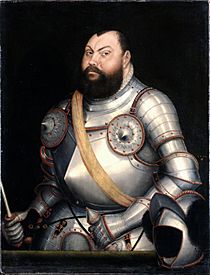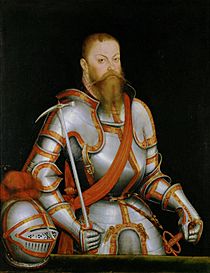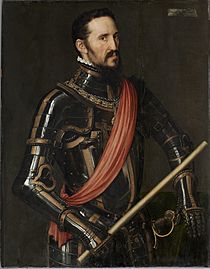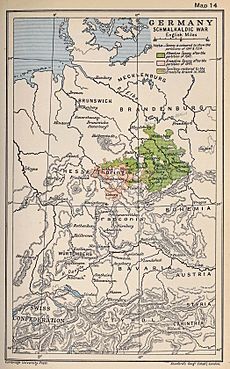Schmalkaldic War facts for kids
The Schmalkaldic War was a short but important conflict that happened in Germany between 1546 and 1547. It was fought between the forces of Emperor Charles V, who was also King of Spain, and a group of Protestant German states called the Schmalkaldic League. This war was a big part of the Protestant Reformation, a time when many people in Europe changed their religious beliefs.
Quick facts for kids Schmalkaldic War |
|||||||
|---|---|---|---|---|---|---|---|
| Part of European wars of religion and the Protestant Reformation |
|||||||
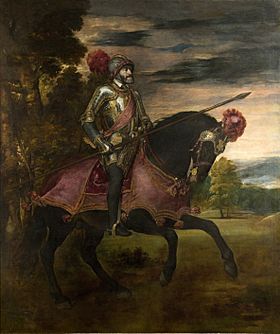 Titian's Equestrian Portrait of Charles V (1548) celebrates Charles' victory at the Battle of Mühlberg. |
|||||||
|
|||||||
| Belligerents | |||||||
Supported by: |
Supported by: |
||||||
| Commanders and leaders | |||||||
|
|
||||||
Why Did the War Start?
During the Lutheran Reformation, many parts of the Holy Roman Empire started following the new Protestant religion. The ruling House of Habsburg, who were Catholic, did not like this. They saw it as these states trying to gain more power and independence from the Emperor.
In 1521, Emperor Charles V declared Martin Luther an outlaw at the Diet of Worms. This meant it was illegal to support Luther or spread his ideas. Anyone who did could lose their property. However, Luther was very popular, so it was hard to enforce this ban.
Later, a meeting called the Diet of Speyer (1526) temporarily allowed religious freedom. But this was changed back at the Diet of Speyer (1529). This led to a group of princes protesting, which is where the term "Protestant" comes from.
In response, several Protestant states formed the Schmalkaldic League in 1531. This league was led by John Frederick I of Saxony and Philip I of Hesse. At first, a peace agreement in 1532 gave them religious freedom.
However, in 1544, Emperor Charles V returned to Germany after a war in Italy. He started making alliances, even with some Protestant princes. One important ally was Duke Maurice of Saxony, a cousin of John Frederick I.
The Schmalkaldic leaders met in July 1546. They knew the Emperor had more money and could raise a bigger army. But they also realized they could gather their troops faster. So, they decided to attack first. Martin Luther had died earlier that year, which removed a major reason against war. Luther had always argued against fighting the Emperor.
Emperor Charles V gathered a large army of about 52,000 soldiers. These soldiers came from Germany, Italy, Spain, and the Netherlands. His plan was to start his campaign along the Danube River.
Key Events of the War
The war began in a region called Swabia. An army from several Protestant cities took over the Catholic town of Füssen. This made the Emperor's forces move towards the fortress of Ingolstadt. The Schmalkaldic princes had thought about invading Tyrol to stop the Emperor from bringing in Italian troops, but they didn't agree on this plan.
Duke William IV of Bavaria and Archduke Ferdinand I of Austria both stayed neutral. This allowed Charles V to gather his strong army without being bothered.
The Schmalkaldic leaders also couldn't agree on fighting the Emperor's well-defended troops. On July 20, 1546, Emperor Charles V declared John Frederick I and Philip I outlaws. He said they had removed a Catholic duke from power in 1542.
Duke Maurice of Saxony used this chance to invade his cousin John Frederick I's lands in October. He did this with help from Ferdinand I, King of Bohemia. This forced John Frederick I to turn his army around from Swabia. He quickly returned and freed his lands. Then he invaded Maurice's lands and parts of Bohemia. As winter arrived, the fighting stopped without a clear winner.
In Swabia, the Hessian troops stopped fighting. The other Protestant cities and princes, like Duke Ulrich of Württemberg and Count Palatine Frederick II, decided to surrender to the Emperor.
On March 28, 1547, Charles V moved his army to Bohemia. There, he joined forces with his brother, King Ferdinand I. The Bohemian Protestants did not help John Frederick I as he had hoped. This forced John Frederick I to retreat.
Due to disagreements in their strategy, the Schmalkaldic League's defenses finally broke. This happened on April 24, 1547, at the Battle of Mühlberg. John Frederick I was captured during this battle.
After the Battle of Mühlberg, which decided the war, only two cities kept fighting: Bremen and Magdeburg. Both cities refused to pay the fines Charles V demanded. They also avoided being taken over by the Imperial troops. In Bremen, 12,000 Imperial soldiers tried to besiege the city from January to May but failed.
This led to the Battle of Drakenburg on May 23, 1547. A Protestant army was raiding nearby lands. Duke Eric II of Brunswick-Calenberg, leading the Imperial forces, was tired and low on supplies. He went to fight the Protestant army and was quickly defeated. Eric had to swim across the Weser river to save himself. After this battle, the Imperial troops left northern Germany.
What Happened After the War?
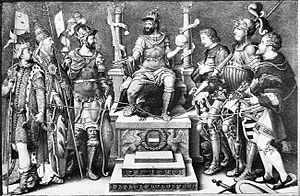
John Frederick I, who was captured, was first sentenced to death. To avoid this, he signed the Capitulation of Wittenberg on May 19, 1547. He lost his title as an elector and some lands to his cousin Maurice. Maurice was then declared the new Saxon Elector on June 4.
Maurice, with help from Elector Joachim II Hector of Brandenburg, tried to help his father-in-law, Philip I of Hesse. Philip surrendered in Halle, hoping for the Emperor's mercy. However, Charles V immediately imprisoned him. This made the other Electors upset because of the Emperor's harshness.
Even though the Imperial forces won the war and defeated the Schmalkaldic League, Luther's ideas had spread too much across Europe to be stopped by force. On May 15, 1548, Charles V, feeling very powerful, issued the Augsburg Interim. This was a temporary law meant to bring Protestants back into the Catholic Church.
But this law caused another revolt by Protestant princes in 1552, known as the Second Schmalkaldic War. This time, Elector Maurice of Saxony led the Protestant princes, and they were supported by King Henry II of France. Charles V had to flee from the stronger Protestant forces. He had to cancel the Interim with the Peace of Passau. This peace agreement also released John Frederick I of Saxony and Philip I of Hesse from prison.
Three years later, an official agreement recognizing the Protestant religion was made. This was called the Peace of Augsburg. The next year, Charles V gave up his throne to his brother Ferdinand I.
See also
 In Spanish: Guerra de Esmalcalda para niños
In Spanish: Guerra de Esmalcalda para niños
- Thirty Years' War
- Confessionalization
- Battle of Mühlberg
- Capitulation of Wittenberg


